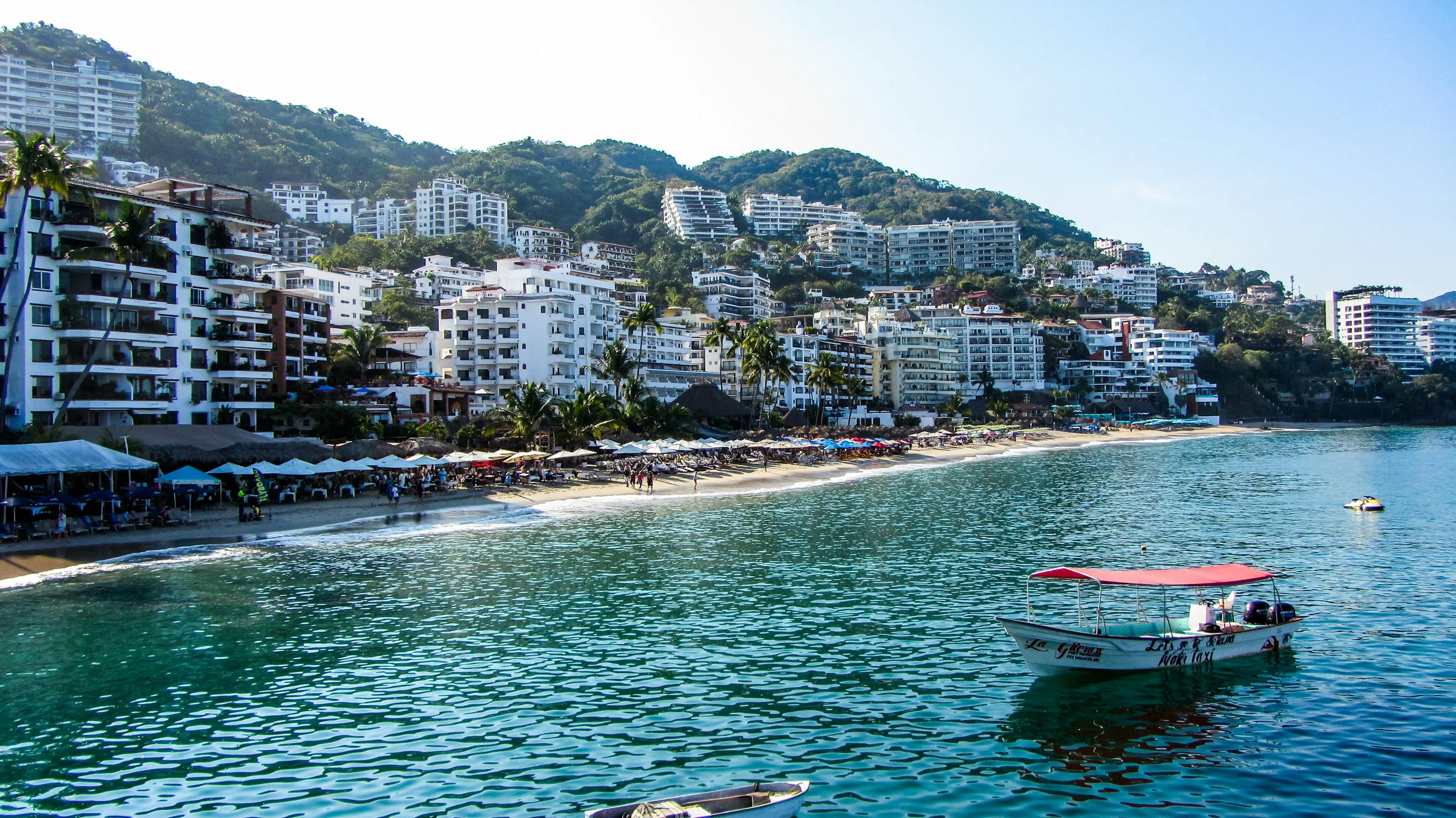Over the last eighteen months, I’ve heard Isla Holbox mentioned more and more—by friends who visited on day trips or short stays, or by others in passing. Either way, its 42 km length and 36 km of pristine white-sand beaches piqued my interest.
Located in the Yum Balam Nature Reserve and founded by pirates, I was eager to see if Holbox was the next ‘big thing’ in Mexican island living.
After two ferries and a three-and-a-half-hour bus ride, I arrived. Holbox is a sandy spit of an island, just two kilometers wide, stretching across the northern tip of the Yucatán Peninsula. As an island lifestyle lover, it was a local trip from my island home of Cozumel, which lies off the eastern coast of the Yucatán Peninsula.
I hoped to find the next island paradise, where long beach walks and a slower pace of life defined the experience. For nature lovers, eco-conscious expats, and those longing for a simpler way of life, Holbox is perfect. The rich waters where the Gulf of Mexico meets the Caribbean support a stunning array of ecosystems and wildlife.
At first glance, Holbox reminded me of Isla Mujeres or Cozumel twenty years ago—blue skies, sandy streets, sea breezes, relaxed locals, abundant sunshine, and pristine nature. It left a strong first impression.
The Reality of Holbox
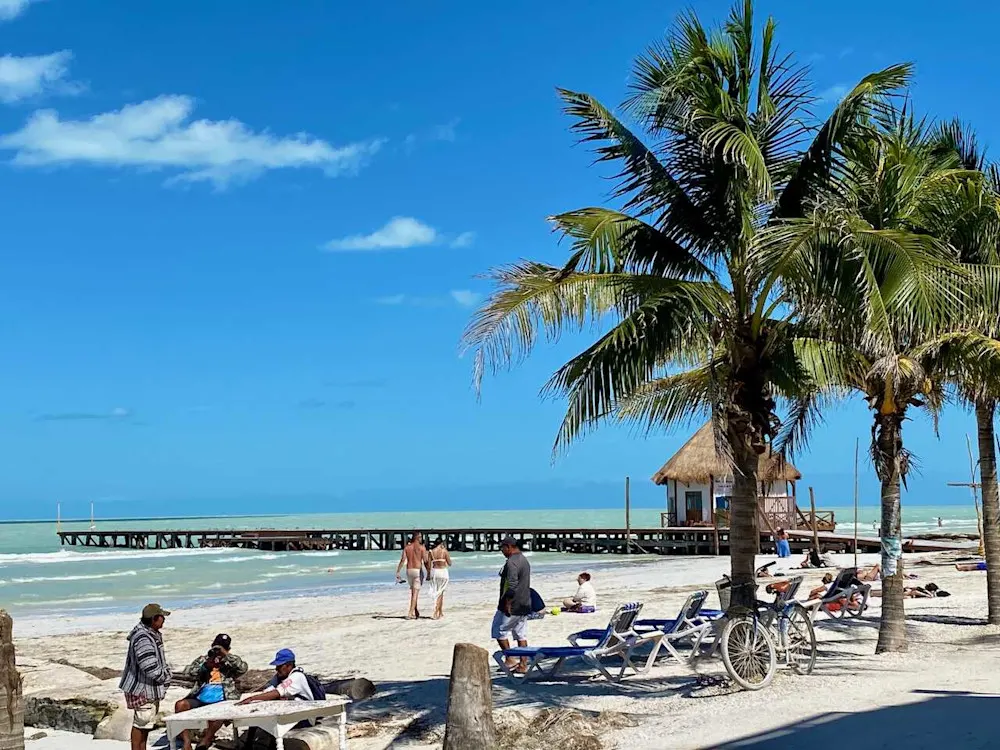
But I won’t lie, it’s marketed at tourists, and the prices are higher than I expected in restaurants and grocery stores. It was also interesting to hear visitors’ points of view.
“I was surprised by the prices. I mean, it’s a tiny island with no infrastructure, but they charge more than Cancun or Playa.” Denis, a tourist, remarked as we were waiting for a foodie tour to begin one night. And I have to say, I agreed. But then again, I’ve lived in the region for eight years, so I know what things cost in Cancun, Playa del Carmen, Tulum, and, of course, my island home of Cozumel.
I’m not saying this to brag that I live a Mexican Caribbean Island dream life. I say this as a foundation so you know that the comparisons made are fair. So that you believe me when I say that the prices are up there. Not just in restaurants, for everything. Groceries, wine, real estate, banking. But you can rent cheaply, which is good news, as it may help you balance it out a bit. Over my week-long stay, everything was checked out and verified.
Both by myself and also by locals living on Holbox. My waiter in Painapol, one of the most popular restaurants in town, backed it up by saying, “I’ve lived here for five years, and it’s a nice island life but expensive.”
So let me start by telling you about Holbox; then we can dive into the different aspects of life there.
Navigating Holbox
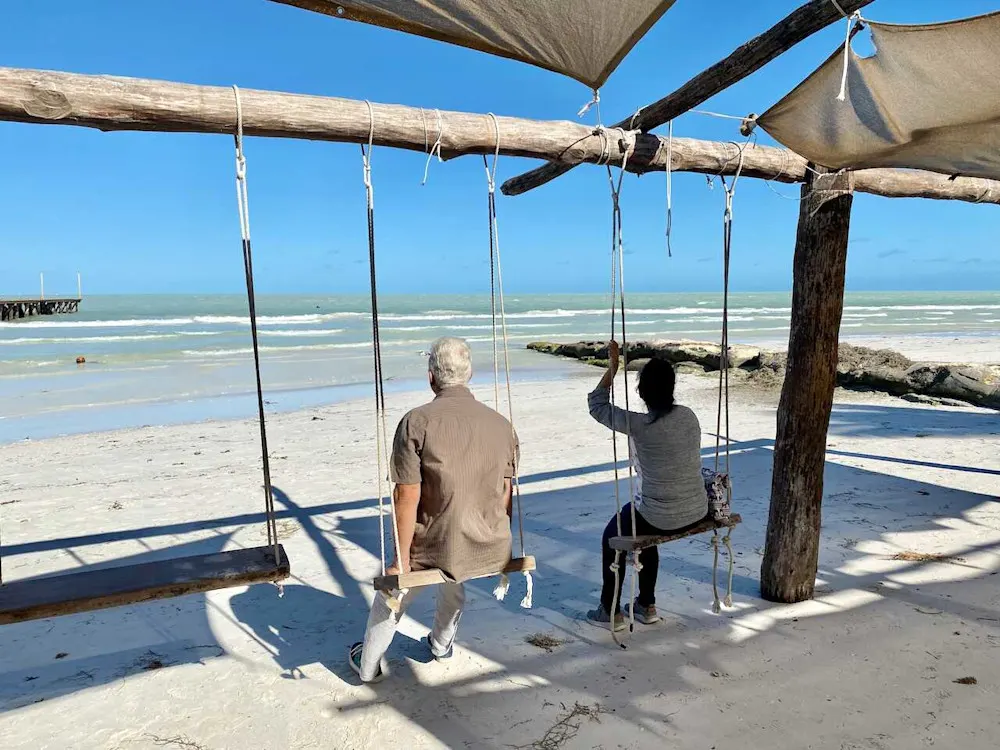
Holbox’s white sandy main street runs two kilometers from south to north, stretching across the island from the ferry terminal. This makes navigation simple, as all roads branch off Calle Tiburón Ballina, Holbox’s main street.
Like all small towns, some street signs are missing, but you can easily find your way by asking a local. The people here are friendly, welcoming, and genuinely kind. There’s no ulterior motive or pushy calls of “come to my shop”, which is a refreshing change from other highly touristic places in the region.
In town, bright murals burst with color along the streets. One particular corner in the town square is even called “The Colorful Corner” due to the vividly painted restaurants on either side of the road. It’s delightful and serves as a landmark on the self-guided walking tour of Holbox, which costs $7–$8 USD, depending on the exchange rate.
This walking tour was the first thing I did on Holbox, and for a few reasons: firstly, to get my bearings right away, and secondly, to see the major landmarks and highlights of the island. It’s a fun way to spend the morning and get a feel for how spread out everything is, whether it’s a walkable town, or if taxis need to be factored into a monthly budget.
The good news? Holbox is very walkable—unless it rains.
When bad weather hits, Holbox’s charming white sandy streets turn into slippery sludge, making getting around tricky. For this reason, it’s worth considering which months you visit.
Accessibility and Infrastructure
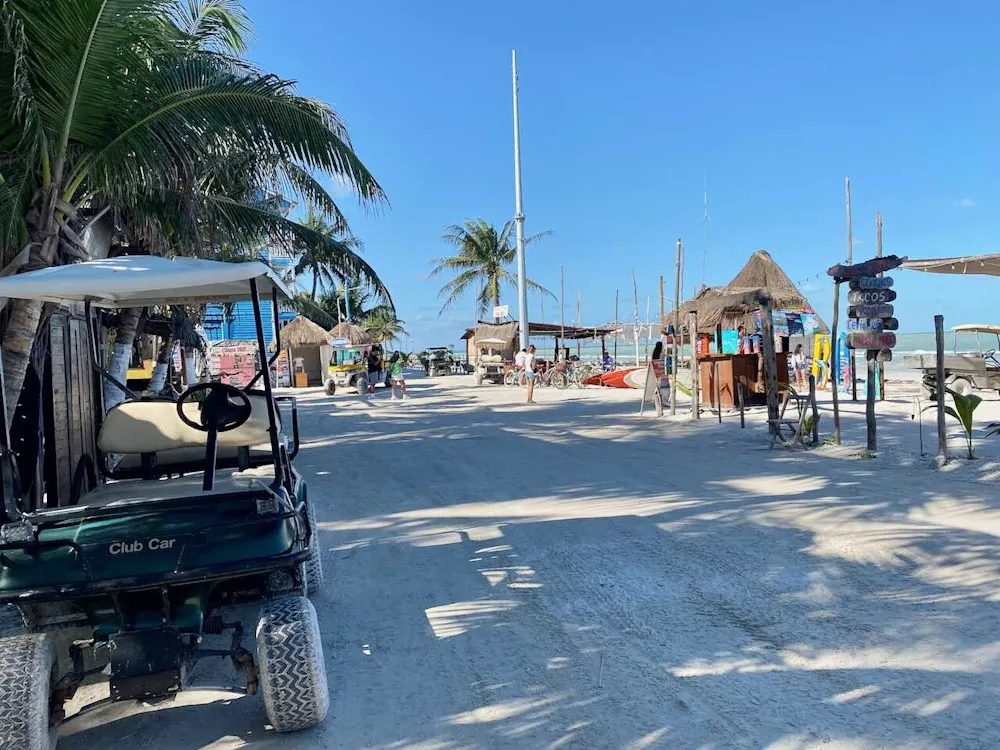
From Cancún International Airport, the closest major airport and the largest in the state, you have several transport options: buses, shuttles, collectivos, or a private driver. The choice is yours, and prices vary depending on departure location and type of transport.
Since I live in Cozumel, I took the ADO bus from Playa del Carmen to Chiquilá, which cost 396 pesos ($20 USD)—a great price for a three-and-a-half-hour ride.
At the higher end of the scale, a highly recommended private transport service with Luis Ángel costs 2,300 pesos ($115 USD) per person from Cancún Airport to Chiquilá, or 4,000 pesos ($200 USD) round trip. They also accommodate large groups and families.
Most people opt for the ADO bus from Cancún to Chiquilá, which costs between 203 pesos and 360 pesos ($10–$17 USD) depending on the time of day.
Taking the Ferry to Holbox
The good news? Ferries run from Chiquilá to Holbox every half hour, so it doesn’t matter when you arrive in Chiquilá.
Two main ferry companies operate the route:
Holbox Express – 300 pesos ($15 USD) one way, running from 6:30 AM to 9:30 PM.
9 Hermanos – 300 pesos ($15 USD) for adults, 200 pesos ($10 USD) for Quintana Roo residents, and 160 pesos ($8 USD) for children. This ferry runs from 5 AM to 9 PM.
Holbox Express is a newer, twin-hulled ferry, which makes for a smoother ride in rough weather. The 9 Hermanos ferry, which I took, is slightly older and a single-hulled vessel, but it was still comfortable for the 25-minute ride across Yalahau Lagoon to the island—even on a rainy arrival day.
Even in bad weather, arriving at Holbox was magical—I was greeted by the sound of gulls crying overhead, pelicans perched nearby, and small Ruddy Turnstones darting around the dock. It was a beautiful welcome to the island.
Upon arrival, you can walk or take a fun local golf cart taxi to your accommodation.
Getting Around Holbox
Because the streets are natural and made of sand, they are uneven and heavily potholed. Bits of rubble are used to fill potholes, so pay attention while walking—it’s very easy to take a tumble or turn an ankle.
For this reason, the local taxis are built for the job. These 4WD golf carts with all-terrain tires and a roll cage can handle even the largest potholes—some of which turn into small ponds after a heavy rain, with water rising halfway up the driver’s door as they slosh through the sandy grey water.
That said, they’re a fun way to get around, and you’ll find taxi stands in Town Square, at the ferry docks, along the waterfront, or you can simply flag one down on the street.
Preserving the Natural Environment
Since Holbox is part of the Yum Balam Nature Reserve, its sandy streets will always remain untouched by pavement to preserve the island’s natural environment.
Culture and Cuisine
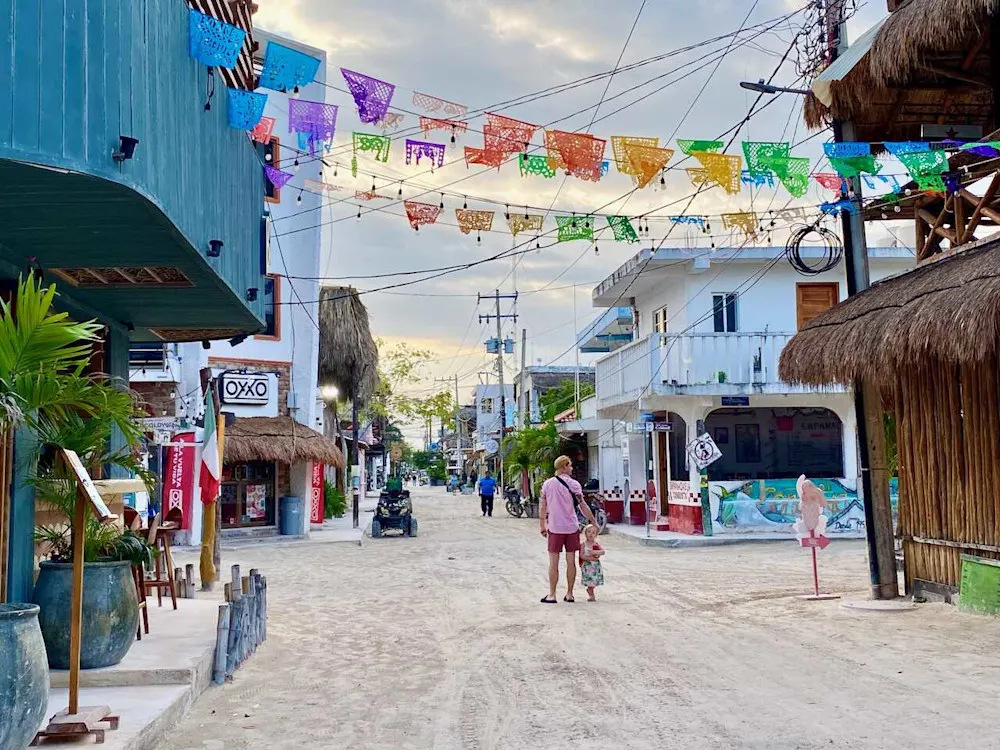
Prepare for tummy rumbles as the smell of fresh seafood draws you along the beachfront. After all, being right on the Gulf of Mexico, Holbox is famous for its lobster and seafood.
But there’s more than just seafood. Wood-fired pizzas, vegan and vegetarian restaurants, artisan bakeries, and cute cafés are scattered around town. However, in-town prices are higher than in other major tourist spots like Cancún, Playa del Carmen, or Tulum.
Along the waterfront, like most beachside towns, expect to pay more. One restaurant had a menu showing lobster pizza for 749 pesos ($40 USD, nearly $60 CAD). However, just one block from my apartment stay, a local pizza place served the same dish for 226 pesos ($12 USD). So, if you venture beyond the tourist zone, you can find more affordable options.
The good news? Fun activities like a five-restaurant tasting tour were only $38 USD—meaning you could try five different restaurants for the same price as one lobster pizza.
Holbox has plenty of activities. Along the beachfront, shacks sell tours of the bio reserve. You can try:
Kayaking through Holbox’s famous bioluminescent waters at night—one of the few places in Mexico where you can see this phenomenon.
Kite surfing, bird-watching tours, eco-excursions, and boat tours to see or swim with whale sharks.
Fishing charters and boat trips to hotspots around the nature reserve.
Some of the most popular boat tour stops include Bird Island, Passion Islan, and the freshwater spring Yalahau—where pirates once refilled their freshwater reserves.
Booking tours directly on the beach is cheaper. Instead of paying $48 USD online, you’ll pay 500 pesos ($25 USD) in town. So, if you splurge on seaside dining, at least activities are affordable to balance things out.
My boat tour had one of those rare, breathtaking moments you only get in bio reserves.
A large pod of dolphins cruised alongside us as we made our way back from Yalahau. The captain cut the engine, letting us idle peacefully while mothers and babies surfaced just a couple of meters from our boat.
As I said, Holbox is a place for nature lovers.
Cost of Living
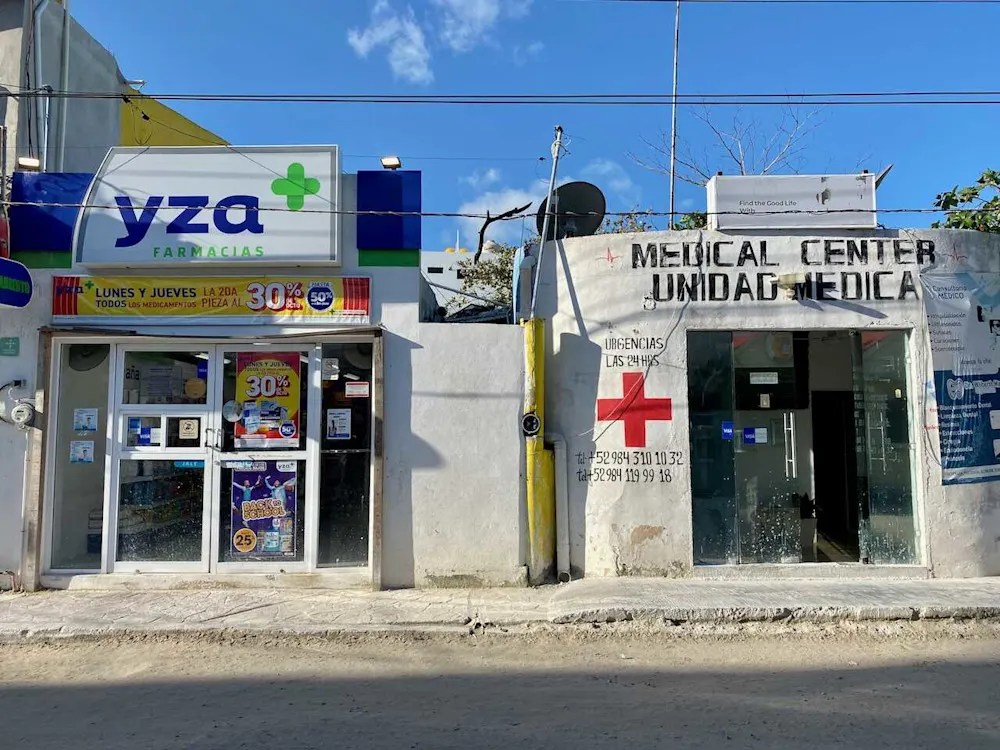
There were no full-time expats living on Holbox that I came across while exploring. Minerva, the lady who rented me an apartment for the week, said, “I have many American friends, but none live here full time. They come for a few months and leave.”
It’s easy to see why with the cost of day-to-day items and groceries. Lack of variety and availability is an issue. Two types of cheese and mostly processed meats were the only things at the tiny supermarket I went into, so you can forget having a wine and cheese night on Friday nights. Fresh fruits and vegetables are basic in all of the stores I found as I walked most of the island. Also, being a small island, things run out or are not available.
That applies to money as well. ATM’s regularly run out of money, and even when they are accessible, the fees are bordering on extortionists’ prices. Calling into BBVA in town, the fee was 197 pesos, $10, almost $15 Candian. While we all have to pay ATM fees, these are the highest I’ve seen in all my travels worldwide. I don’t know anyone who would happily pay $15 just to access their money.
If you are thinking of a scouting trip to Holbox, take enough pesos with you in case the ATM runs out. Lack of money isn’t the only issue. Access to medical care is limited to one tiny medical center. So small I walked past it three times without realizing. But there are a few pharmacies along the main street and combined with the medical centre you’d be okay with minor injuries or if you get the sniffles. For larger medical issues, specialist accessibility, treatments or dental work, people go to Cancun or Cozumel.
My tour guide Alex said “if we need anything, like medical stuff and perscriptions, we go to Cozumel.” Something I found very interesting. Considering the great infrastructure, excellent medical care with full range of English-speaking specialists, movie theatres, fully stocked supermarkets, a SAMS Club, a planetarium, and over 500 restaurants, Cozumel is cheaper and has everything you need or want.
But for those looking for a quiet, basic, nature-filled life, Holbox is beautiful, so I was curious about the price of real estate.
Housing
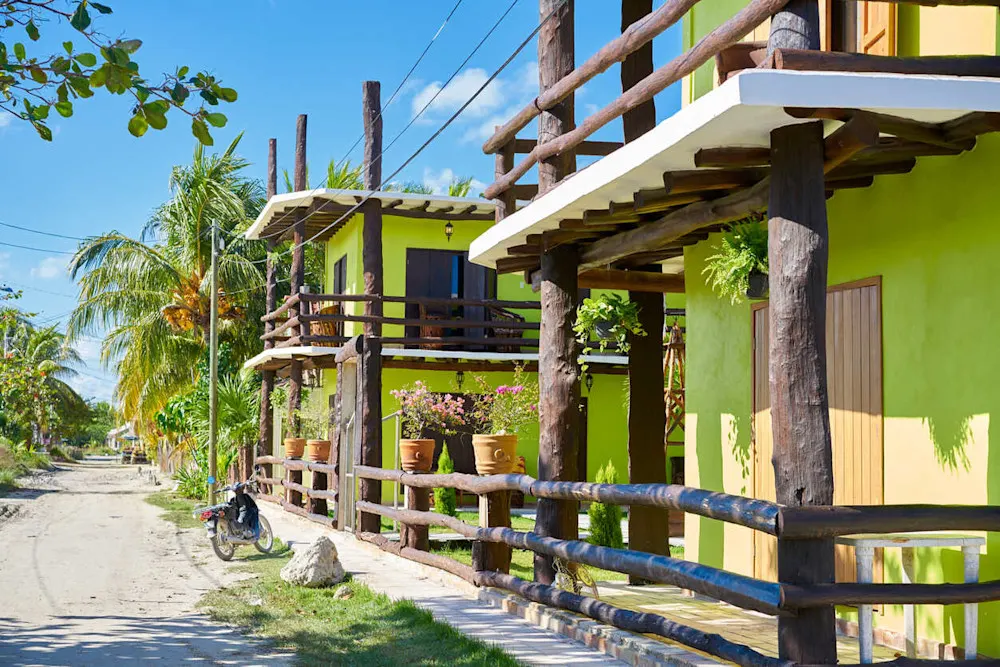
There is only one small real estate office on the island.
Starting with land, a 169-square-meter lot was listed for just over $268,000 USD.
For those looking for a tiny home, a 45-square-meter converted shipping container was priced between $58,500 and $117,000 USD.
And for investors, an apartment complex with nine furnished apartments was selling for $1.2 million USD.
Considering Holbox is in a hurricane corridor, I’m not sure a metal shipping container is as stable as I would want. These high prices—combined with limited amenities—may also explain why most people don’t make Holbox their home year-round. Instead, they visit for a few months or enjoy a snowbird season.
Rentals can be found at lower prices. I saw a small, unfurnished studio for $345 USD per month, with internet included, but not electricity, water, or gas. It was also not pet-friendly—perfect for someone on a tight budget.
Flo Mendez, a local recommended in the Holbox Facebook group, had a two-bedroom, one-bath rental with a garden and air conditioning, just a two-minute walk from the beach in town, for $590 USD per month.
She’s a great contact if you’re looking for a rental—reach her at +52 998 354 1564.
Holbox has only a few high-season months, when Mother Nature shares her treasures—like abundant bioluminescence in July and August or whale sharks in the area from June to September.
This draws a lot of tourists, so if you’re renting, double-check to ensure your rent doesn’t change month to month.
But here’s great news for digital nomads looking for a quiet, natural place to work for a few months:
During my week-long stay, the apartment’s internet was perfect. And, to be honest, there were a few days of high wind and rain, but the connection held up well. I’m confident that a digital nomad could work from the island even in less-than-ideal weather.
Final Verdict: It’ll Be a While
As I mentioned earlier, I’m an island and nature lover—but even with that in mind, Holbox wouldn’t be my choice for full-time living.
Holbox is undeniably stunning for a visit, but it’s not yet practical for those looking to settle down permanently. For island living in Mexico, there are better options that offer modern amenities, a lower cost of living, full medical facilities, and access to English-speaking specialists—not to mention a greater variety of fresh food.
That said, for digital nomads seeking an island escape for a few months or snowbirds looking for six months of peaceful nature, Holbox could be ideal. Along the beach, there are beautiful, spacious rentals perfect for those looking for a luxury stay. And with plenty of great restaurants to enjoy at night and wide, pristine beaches for long walks during the day, it’s certainly a paradise for the right kind of traveler.















